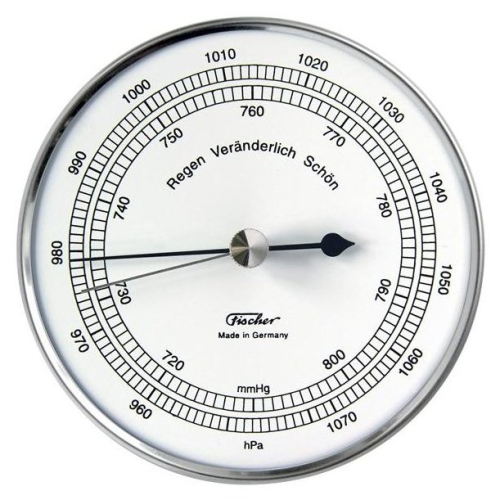Aneroid barometer
1 product
Showing 1 - 1 of 1 product
In can barometers, also known as aneroid barometers (from Greek: α-νηρός "a-nerós" "not liquid"), a can-like hollow body made of thin sheet metal is deformed by atmospheric pressure. A residual pressure of approximately 5 mbar (= 5 hPa = 500 Pa) exists within the can, which compensates for the change in the sheet's elastic modulus due to temperature.
Such a hollow body is also called a Vidie can after its inventor, Lucien Vidie (1805–1866). From 1881 onward, Gotthilf Lufft became the first manufacturer of can barometers in Germany. He further developed the Vidie can and filed his own patent in 1909.
Better barometers or barographs use a stack of up to eight such "cans" stacked on top of each other to increase the sensitivity of the measurement. A mechanism transmits this deformation—compression when air pressure increases and expansion when pressure decreases—to a pointer.
One problem here is the temperature sensitivity of such a system. The components of the can itself exhibit thermal volume expansion, and therefore special alloys are used in its construction. Several components compensate for each other's temperature behavior, thus reducing the disruptive effect of thermal expansion. However, temperature-related measurement errors still occur. Pressure microphones and altimeters also operate according to this principle.
Vidie cans are also used in aviation for altimeters, variometers and airspeed indicators.
tube barometer
The tubular barometer, or Bourdon tube, takes advantage of the fact that the outside of a bent tube has a larger surface area than the inside, and thus the external force is greater as pressure increases. The deformation, depending on the pressure, is transmitted to a pointer.

